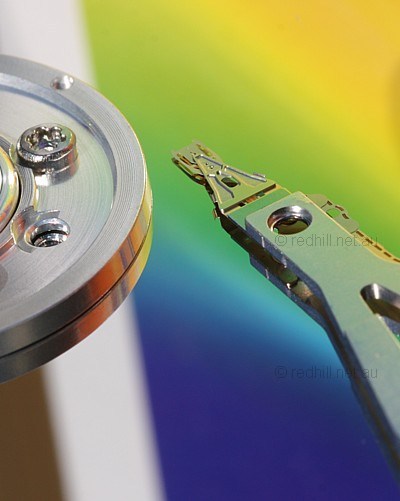
Samsung SP2014N (200GB, 2005).
Update your bookmark
This is the old site. You probably want the new site.
The new site has all the same information but adds more drives, updated text, and much better pictures of many models.
- Western Digital Caviar 2.1
- Seagate Medalist 5400
- Quantum Fireball SE
- IBM Ultrastar 9ES
- Seagate Medalist 10240
- Quantum Bigfooot TX new
- Seagate Medalist Pro 7200
- Western Digital Caviar 3.2
- IBM Deskstar 16GP
- IBM Deskstar 14GXP
- Quantum Fireball EL
- Samsung SpinPoint V3200
This old version of the Red Hill guide hasn't been updated for about ten years. The new version can be found here.
A much more varied year was 1998. Where we'd sold little else but IBM drives the year before, in '98 we saw a lot of Western Digitals and a very welcome return to the mainstream market by Seagate. It was transitional in another and more important way too: most of the technologies that dominate and shape the current hard drive market were just becoming available for the first time: higher spin-rates, GMR heads, renewed emphasis on shock resistance and reliability, higher areal density and most of all massive, affordable capacity. In a way, it was the last "traditional" hard drive year — it seemed little different to 1997 or '95, and yet the changes that it brought in were to revolutionise the world of storage.
Western Digital Caviar 2.1 and 2.5
After a lean year or two, a dose of new technology in their 1998 range brought Western Digital right back to the front of the performance pack. Seek time went down to 9.5ms, they spun slightly faster at 5400 rather than WD's traditional 5200 RPM and they had 256k cache — twice as much as most of the older WD drives.
The Caviar 5400s had a magnificent reliability record for the first six or eight months of their life: indeed, we sold a truckload of them and had them listed here for a short time with our highest rating, and we do not award that lightly. But then we had a period of six months or so when we saw a number of failed units — and, as if to confound our newfound lack of confidence in them, very few failures since that time. We are not sure how to explain this: we sold so many 5400s that we don't think random chance can have had much to do with it. We can only surmise that Western Digital's usual excellent QC standard slipped for a short while, then recovered.
With good performance, great pricing, and outstanding reliability, these were easily our best-selling drives for the summer and autumn of '98; they still sold well through winter, and only slowed as the march of time caught up with them in the last months of the year. As a matter of interest, the drives that eventually pushed the WDs off our best-seller list were the Seagate Medalist 5400 (similar speed but cheaper), the Quantum EX and EL (similar price but faster) and the Seagate Medalist 7200 (more expensive but very fast). By the time the follow-on series arrived we had switched.
| Performance | 1.10 | Reliability | AA2 |
| Data rate | 135 Mbit/sec | Spin rate | 5400 RPM |
| Seek time | 9.5ms | Buffer | 256k |
| Platter capacity | 2.1GB | Interface | ATA-33 |
| AC12100 | 2.1GB | 2 MR heads | **** |
| AC23200 | 3.2GB | 3 MR heads | *** |
| AC24300 | 4.3GB | 4 MR heads | **** |
| AC35100 | 5.10GB | 5 MR heads | *** |
| AC36400 | 6.4GB | 6 MR heads | **** |
| Performance | 1.12 | Reliability | no data |
| Data rate | 148 Mbit/sec | Spin rate | 5400 RPM |
| Seek time | 9.5ms | Buffer | 256k |
| Platter capacity | 2.5GB | Interface | ATA-33 |
| AC12500 | 2.5GB | 2 MR heads | |
| AC25100 | 5.16GB | 4 MR heads | |
| AC38400 | 8.4GB | 6 MR heads | * |
Seagate Medalist 5400 Family
Seagate finally remembered the mainstream desktop drive with this series. Throughout 1997 they had excellent low-cost entry-level IDE drives (notably the long running ST31720) and superb high-end SCSI drives like the Cheetah family but nothing much in between. At a time when the market was demanding fast IDE drives in the 3 to 4GB range, their only 5400 RPM drives were too small (2.5GB) and too large (6.4GB), while the drives they did offer in the popular size categories were competitive only with the ultra low-end Quantum Bigfoot.
With excellent performance in their time and very reasonable cost, the long-running Medalist 5400 series filled the gap for 1998 — and did it with outstanding Seagate reliability (there are very few drives that earn our "AAA" rating). As so often with the very best mainstream drives, there is little else to say about these, bar that we sold a large number of them with perfect satisfaction — it is something of an injustice that it is really only the worst products in any particular area that garner much attention. The best things in life just work without fuss or bother and we take them for granted.
To appreciate how much drive technology improves over the years, compare the 2.1GB version (one of the last drives of this size ever manufactured) with the ST-32140 on the page above (the world's first 2GB IDE, introduced in February 1996 and long out of production by the time these arrived, of course). The newer drive had only two heads instead of eight, more than double the data transfer rate, and cost less than half as much to manufacture. Only the seek time was similar, and seek time is the most difficult of all drive performance factors to do much about unless cost is not an issue.
| Performance | 1.07 | Reliability | AAA |
| Data rate | 140 Mbit/sec | Spin rate | 5400 RPM |
| Seek time | 10.5ms | Buffer | 128k |
| Platter capacity | 2.1GB | Interface | ATA-33 |
| ST32110 | 2.1GB | 2 MR heads | *** |
| ST33221 | 3.2GB | 3 MR heads | **** |
| ST34321 | 4.3GB | 4 MR heads | **** |
| ST36531 | 6.5GB | 6 MR heads | ***** |
| ST38641 | 8.6GB | 8 MR heads | ** |
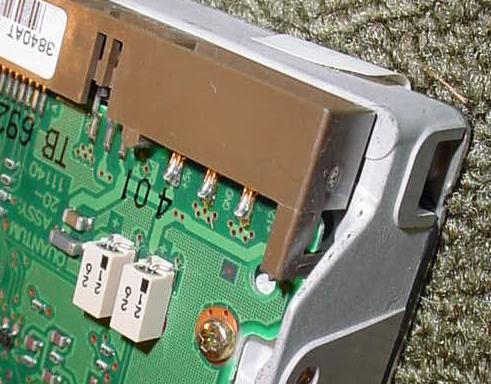
Quantum Fireball SE
After a very successful 1997, Quantum outdid their excellent Fireball ST series with the even faster Fireball SE. The performance improvement was significant — from 132 to 158Mbit/sec is almost 20% — and that was coming from an already outstanding drive. Seagate and IBM both introduced even faster drives at the high end of the IDE market not long after these arrived, but had to go to 7200 RPM spindle speed to get more than a marginal improvement. In 5400 RPM drives, only the IBM Deskstar 16XP family was faster than the Fireball SE during its market life, and at a mere 4Mbit/sec the difference was very small. The SE was the benchmark drive of 1998, just as the Fireball ST had been in 1997.
Nevertheless, we preffered to use an IBM or a Seagate for reliability-critical tasks as the SE's failure rate was a fraction higher than we would have liked. Perhaps with their Fireballs from this period, Quantum did what Western Digital did in 540MB days — went a little too far in the speed direction while arriving at their speed-reliability compromise. Most drives fall clearly into one reliability category or another, but our Fireball SE rating is rather tentative, given the relatively small numbers of them we sold new. Indeed, were it not for a simple mechanical design problem with them (more on this in a moment), we might have been tempted to sneak them into the AA1 category.
The design flaw was a traditional Quantum weakness: the flimsy mounting for the power supply socket. A trivial thing perhaps, but it made it all too easy to destroy a brand-new drive with very little force. Standard plastic four-pin PC power supply plugs vary marginally in size from one batch to another. If the plug is a little oversize or the socket a little too small, then it can take quite a firm push to insert the power lead. In the case of the Fireball SE, the mounting of the socket is so flimsy that it is all too easy to break the PCB and thus ruin the drive. (With most other drives, you would have to be a gorilla and a drunken one at that.)
Worst of all, Quantum displayed no willingness whatever to repair these damaged PCBs. If you broke it you just had to buy another one. Contrast this with Seagate's attitude when they had a similar problem with the old 270MB Medalist (one batch of which had a very stiff, slightly undersized socket connector, which could give rise to the same problem) — Seagate simply shipped new drives by return. Most Fireballs around this time had the same problem, but the newer ones are much better, stronger now than most other brands. Just remember to take great care if you're plugging in a Fireball SE, ST or TM.
| Performance | 1.13 | Reliability | AA2 |
| Data rate | 158 Mbit/sec | Spin rate | 5400 RPM |
| Seek time | 9.5ms | Buffer | 128k |
| Platter capacity | 2.11GB | Interface | ATA-33 |
| SE2.1 | 2.11GB | 2 MR heads | |
| SE3.2 | 3.23GB | 3 MR heads | * |
| SE4.3 | 4.31GB | 4 MR heads | ** |
| SE6.4 | 6.45GB | 8 MR heads | * |
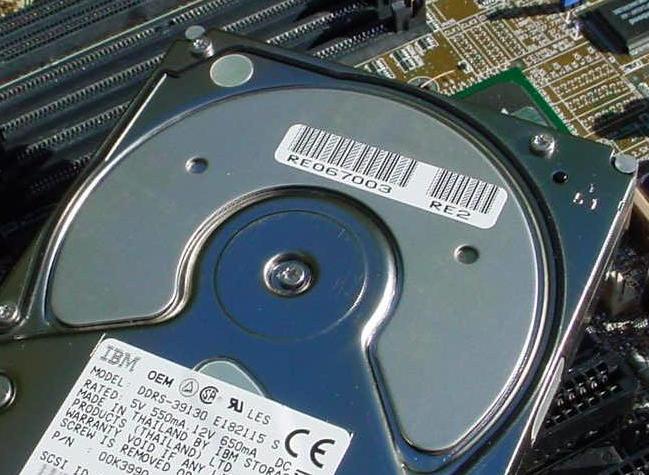
IBM Ultrastar 9ES, 9LP, 18XP
IBM saw the Ultrastar 9ES as an entry-level SCSI drive to take the place of the long-running 5400 RPM Ultrastar 2 series. This in itself was quite an achievement — as the "entry-level" 9ES was easily faster than most 7200 RPM drives when it came out, and not totally shamed by 1997's 10,000 RPM racehorses, the Seagate Cheetah and IBM's own Ultrastar ZX.
Both of these drive families, the 9ES and the higher-performance 9LP/18XP, used IBM's leading-edge Extended Magneto-Resistive (MRX) head technology to squeeze more data onto each disc.
The 9LP and 18XP were faster again, though only by a small margin on paper. We have never quite worked out the point of making two drives as similar as the two 9GB models below — the LP had a bigger cache and was positioned higher in the market, but both had 7200 RPM spindles and ten heads, they were only one millisecond apart in seek time, and the data transfer rates were almost identical. Then again, sometimes we think that not even IBM understand IBM's marketing, so what hope do we have?
In reality, the explanation is, no doubt, that the top of the range 9LP/18XP drive was the best 7200 RPM drive that IBM could produce at the time (i.e., a "normal" model), but that the 9ES was unusual: IBM had decided, quite correctly, that the future of 5400 RPM entry-level SCSI drives was limited and jumped their Ultrastar 2 replacement up to 7200 RPM. Seagate were finishing up their long-running 5400 RPM SCSI Hawk line at about the same time for much the same reasons. The 9ES, in other words, had out-of-category performance almost by accident, and was a real bonus for drive buyers. Our Red Hill workshop server still runs a pair of 9ES drives alongside two early-model 10,000 RPM units. We remain fond of them.
Note that, as always, we don't give a reliability rating for SCSI drives: both because we rarely see enough of any particular model to justify one, and because all 'real' SCSI drives — that is, purpose-manufactured ones, as opposed to cheap IDE drives with a SCSI interface grafted on as an afterthought — should be in the AAA+ class as a matter of course. Given the price of them, anything less is unacceptable.
| Ultrastar 9ES: | Performance | 1.31 | |
| Data rate | 171.1 Mbit/sec | Spin rate | 7200 RPM |
| Seek time | 7.5ms | Buffer | 384k |
| Platter capacity | 1.83GB | Read Channel | PRML |
| DDRS-34560 | 4.56GB | 5 MRX heads | 3½" 1/3 height |
| DDRS-39130 | 9.13GB | 10 MRX heads | 3½" 1/2 height |
| Ultrastar LP & 18XP: | Performance | 1.38 | |
| Data rate | 179.2 Mbit/sec | Spin rate | 7200 RPM |
| Seek time | 6.5 or 7.5ms | Buffer | 1MB |
| Platter capacity | 1.83GB | Read Channel | PRML |
| DGHS-39110 | 9.11GB | 10 MRX heads | 3½" 1/3 height |
| DGHS-318220 | 18.22GB | 20 MRX heads | 3½" 1/2 height |
Seagate Medalist 10240
One of the major changes that swept across the storage industry in 1998 was the massive increase in drive capacity. Where as recently as one or two years before, buyers were usually lined up waiting for bigger hard drives, this was the year in which the industry finally outstripped the demand for ever-more storage space and in which we saw an almost total lack of buyer interest in the largest possible drive.
Large IDE drives were very slow to take off in the marketplace. Demand for 8GB drives and bigger was minimal in 1998 and remained sluggish right up until the end of the decade. Although 6.4GB drives sold like crazy and 8GB drives were gradually becoming popular around this time, 10GB still seemed to be the limit as late as June 1999. This would change, of course, but not soon enough for the Medalist 10.2.
This was not a particularly fast drive when it first came out, and for such a big drive it was looking distinctly sluggish when it was eventually retired. By the time 10GB drives were regarded as standard fare for the entry-level (early in 2000), these had long since disappeared: replaced by significantly cheaper and faster new models.
Like the 8.4GB Medalist 5400 these had eight heads and ran at 5400 RPM: the extra capacity came from higher areal density, which also explained the higher data transfer rate.
| Performance | 1.08 | Reliability | no data |
| Data rate | 148 Mbit/sec | Spin rate | 5400 RPM |
| Seek time | 10.5ms | Buffer | 128k |
| Platter capacity | 2.56GB | Interface | ATA-33 |
| ST-310240 | 10.24GB | 8 MR heads |

1998 Drive of the Year
Seagate Medalist Pro 7200 Family
With this drive Seagate finally reclaimed their traditional title as the high-performance leader. The Medalist Pro 7200 was the world's first 7200 RPM IDE drive, and its data transfer rate was almost 200Mbit/sec — roughly double the speed of most drives sold in 1997, and faster than all but a very few of the most expensive SCSI drives too. These were only a little more expensive than other IDE drives and were significantly faster than any competitor.
Substituting one of these for a 5400 RPM drive increased overall system benchmark performance by about twice as much as upgrading the CPU by one grade (i.e., from a 200 to a 233), but the effective performance increase was much greater — as the tasks most affected by hard drive performance are more noticeable to the user. In other words, you can really see the difference. We loved them.
Over the years since then, many hard drive enthausiasts have come to look at the Medalist 7200 rather scornfully, and complain that they were too hot, too loud, not very reliable, and not particularly fast in any case. This merely illustrates a lack of a proper sense of perspective: in 1998 when the ST-36530 came out, and throughout its too-short a market life, it was far and away the best IDE drive available anywhere.
Whatever other people's experience with them may have been, we sold them in significant volume and had very little trouble. We rather suspect that tales of unreliability have much more to do with unskilled and inappropriate mounting than anything else — a 7200 RPM drive, especially one of these first-generation units, generates a fair amount of heat and needs proper ventillation. As for the performance, the Medalist 7200 was streets in front of any non-SCSI drive, and deserves to be remembered as a ground-breaking pioneer.
Alas, Seagate dropped them completely without warning at the worst possible time: half-way through the Christmas rush of 1998, when they were easily our best-selling drive, and our primary competitive advantage. There was no real alternative: IBM's 7200 was slower, Maxtor's we didn't really trust after our troubles with the 5GB 85120, both were in less useful sizes, and neither was particularly good value for money. We lost a lot of sales because of that and we were seriously pissed off with Seagate. All they needed to have done was let us know a few weeks in advance.
(The particular drive illustrated, by the way, is one of the rare ST36530s that gave us trouble, though not until it had comfortably outlived its three year warranty: we first sold it in October 1998, traded it back and resold it a couple of times over the next few years, and eventually saw it fail gracefully without loss of data — by which time it was in its third system and its fourth year of service.)
| Performance | 1.24 | Reliability | AA1 |
| Data rate | 194Mbit/sec | Spin rate | 7200 RPM |
| Seek time | 9.5ms | Buffer | 512k |
| Platter capacity | 2.35GB | Interface | ATA-33 |
| ST34520A | 4.56GB | 4 MR heads | |
| ST36530A | 6.51GB | 6 MR heads | **** |
| ST39140A | 9.15GB | 8 MR heads | * |
Western Digital Caviar 3.2 and 4.3
Western Digital's product development was often sluggish in the late Nineties. They produced a number of excellent drives but did not always have them out fast enough to really match it in the marketplace with Quantum and Seagate. Even little Maxtor often had a bigger, faster product out first.
In the summer of 97/98 WD got back on track when they brought out a state of the art family of 5400 RPM IDE drives (details here) but by the end of the year that range too was starting to look elderly again, and this new range of faster products for the southern summer of 98/99 was well and truly due. They had been out for quite a while before we started selling them in any volume; mostly because they often used to be priced $10 or $20 higher than they should have been. We liked Western Digital drives here at Red Hill but they sometimes needed to be just a little cheaper to compete with the equivalent Seagates and IBM units. (In the second half of their market life — say, after April '99 — these became excellent value.)
For a while, it looked as though these were going to be the last of Western Digital's own in-house mainstream drives. While WD planned to continue as a manufacturer, around this time they contracted with IBM to manufacture re-badged IBM designs, using many IBM-supplied components. Despite some considerable success with their high-performance Expert line, the arrangement was short-lived. By 2000, Western Digital were designing their own drives again.
(And yes, we cheated. The illustration above right is an unidentified Western Digital 8 head drive. Even the 13GB AC31300 had only 6 heads.)
| Performance | 1.14 | Reliability | AA1 |
| Data rate | 161 Mbit/sec | Spin rate | 5400 RPM |
| Seek time | 9.5ms | Buffer | 512k |
| Platter capacity | 3.2GB | Interface | ATA-66 |
| AC13200 | 3.2GB | 2 MR heads | |
| AC26400 | 6.45GB | 4 MR heads | *** |
| AC310000 | 10.14GB | 6 MR heads |
| Performance | 1.15 | Reliability | AAX |
| Data rate | 171 Mbit/sec | Spin rate | 5400 RPM |
| Seek time | 9.5ms | Buffer | 512k |
| Platter capacity | 4.3GB | Interface | ATA-66 |
| AC14300 | 4.31GB | 2 MR heads | *** |
| AC28400 | 8.45GB | 4 MR heads | * |
| AC313000 | 13.02GB | 6 MR heads |
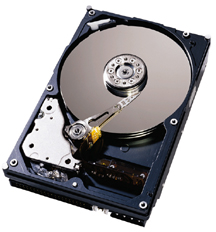
IBM Deskstar 16GP
Along with the Deskstar 14GXP (see below), these introduced Giant Magneto-Resistive heads: another of IBM's continuous series of fundamental improvements to head technology. GMR had become a standard feature in all new drives by the turn of the century. It is hardware technology like this that makes you realise just how little progress software writers manage in comparison.
There were no less than seven individual drives in the Deskstar 16XP family, ranging from a single-platter 3.2GB unit to a five disc 16.8GB monster. Sensibly, IBM standardised on this high-speed drive, even for the entry-level, rather than spending development capital on a dedicated low-end drive. We expected that this would be good news for PC buyers, and hoped that the smaller versions would be very reasonably priced for such a fast drive, but it didn't happen that way. Through much of their market life the 16XPs (of all sizes) were a little overpriced, and in consequence we mainly recommended Seagate, WD and Quantum drives instead. (This left us wondering, if IBM wanted to sell in volume, why didn't they offer these at a sensible price more consistently? And if they didn't want to sell in volume, why have some of their other drives been such outstanding value for money? As always, IBM's marketing department is unfathomable.)
| Performance | 1.14 | Reliability | AAX |
| Data rate | 161.9 Mbit/sec | Spin rate | 5400 RPM |
| Seek time | 9.5ms | Buffer | 512k |
| Platter capacity | 3.2GB | Interface | ATA-33 |
| DTTA-350324 | 3.2GB | 2 GMR heads | |
| DTTA-350430 | 4.3GB | 3 GMR heads | |
| DTTA-350640 | 6.4GB | 4 GMR heads | * |
| DTTA-350840 | 8.4GB | 5 GMR heads | * |
| DTTA-351010 | 10.1GB | 6 GMR heads | |
| DTTA-351290 | 12.9GB | 8 GMR heads | |
| DTTA-351680 | 16.8GB | 10 GMR heads |
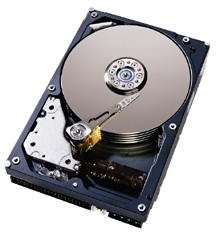
IBM Deskstar 14GXP
Seagate were the first to introduce a 7200 RPM IDE drive, the Medalist Pro 7200, but only just. These were second only to the the big Seagates for speed, with the 5400 RPM Deskstar 16XPs and Quantum Fireball EX family next. (The EX had a higher data rate than the 14GXP but don't underestimate the importance of latency — see the drive ratings page for details.) Like the Deskstar 16XP (above), they used Giant Magneto-Resistive heads — a technology only IBM had for quite some time.
These sold in small numbers only: while they were faster than the best 5400 RPM drives, it was not by as big a margin as you'd expect, and they were inferior to, and more expensive than the Seagate Medalist 7200s. (They were, however, quieter and cooler, if that mattered to you.) In addition, there was no version in the most popular size range: a 6.4 or 7.6GB GXP would have sold much more readily. We sold a handful of the 10.1GB ones as a next-best substitute for the Medalist 7200 after it became unavailable. When the second-generation 7200 RPM drives arrived from Western Digital, Quantum and IBM themselves, the 14GXP dissappeared. Perhaps their main purpose was to show that it wasn't only Seagate who could manufacture a 7200 RPM IDE.
| Performance | 1.21 | Reliability | AAX |
| Data rate | 174.4 Mbit/sec | Spin rate | 7200 RPM |
| Seek time | 9.5ms | Buffer | 512k |
| Platter capacity | 2.58GB | Interface | ATA-66 |
| DTTA-371010 | 10.11GB | 7 GMR heads | * |
| DTTA-371290 | 12.99GB | 8 GMR heads | |
| DTTA-371440 | 14.45GB | 10 GMR heads |
Quantum Fireball EL
An almost forgotten member of Quantum's long-running Fireball series of high-performance desktop drives, which seemed to come in and then be replaced by the EX in hardly any time at all. Performance was only slightly up on the previous Fireball SE, with a marginally higher internal data transfer rate (from 158Mbit/sec to 162 Mbit/sec) and a bigger 512k cache.
Larger on-drive cache was very much the fashion in 1999 — despite no particular evidence that it did anything much for performance — perhaps because the very low cost of RAM by then meant that it was just as easy to have more of it.
Where the previous Quantum Fireball STs and SEs were clear performance leaders, as, to a lesser extent, was the subsequent Fireball EX, the EL merely maintained the existing standard; the major change was a set of improvements to the drive's robustness. This had been an area of concern with the older Fireball TM, ST and SE drives and it was very welcome.
As much because of their odd sizing as for any other reason, we never sold the ELs new here at Red Hill, but the similar and slightly newer Fireball EXs were very impressive. Unusual sizes are always difficult to fit into a model range. It seems that the manufacturers know this, as it is rare to see a drive model outside of the usual sizes.
| Performance | 1.14 | Reliability | no data |
| Data rate | 162 Mbit/sec | Spin rate | 5400 RPM |
| Seek time | 9.5ms | Buffer | 512k |
| Platter capacity | 2.56GB | Interface | ATA-66 |
| EL 2.5 | 2.56GB | 2 MR heads | |
| EL 5.1 | 5.12GB | 4 MR heads | |
| EL 7.6 | 7.67GB | 6 MR heads | |
| EL 10.3 | 10.32GB | 8 MR heads |

Samsung SpinPoint V3200 and V4300 Families
In years gone by, Samsung hard drives were notorious. Warned by the horror stories surrounding the old 125MB SHD, we avoided them religiously. Around the end of 1998 we decided it was time to re-test the water. We had heard some encouraging reports, and Samsung themselves had been trumpeting their improved reliability for some time.
So we put them to the test, very cautiously, starting with this model. Naturally, we didn't buy them in large quantities, nor did we use them for anything mission-critical.
The drives themselves were unremarkable: nicely finished, very reasonably priced, and not noticably faster or slower than similar-sized drives from other makers. As for reliability, we were quite unable to fault them. To be sure, we only sold then in small numbers, but to this day not a single one of our V Series Samsungs has given us the slightest trouble.
| Performance | 1.13 | Reliability | AAX |
| Data rate | 173 Mbit/sec | Spin rate | 5400 RPM |
| Seek time | 10.0ms | Buffer | 512k |
| Platter capacity | 3.2GB | Interface | ATA-33 |
| SV0322A | 3.2GB | 2 MR heads | * |
| SV0644A | 6.4GB | 4 MR heads | * |
| Performance | 1.19 | Reliability | AAX |
| Data rate | 200 Mbit/sec | Spin rate | 5400 RPM |
| Seek time | 9.5ms | Buffer | 512k |
| Platter capacity | 4.3GB | Interface | ATA-66 |
| SV0432D | 4.3GB | 2 MR heads | * |
| SV0643D | 6.4GB | 4 MR heads | |
| SV1296D | 12.9GB | 6 MR heads | * |


